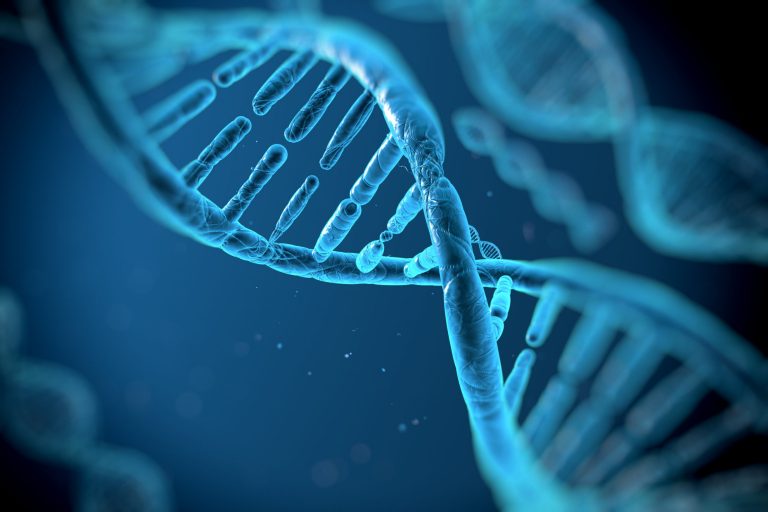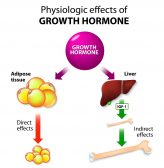Genetic Control – On and Off Genes

DNA molecule
Table of Contents
Reviewed by: Mary Anne Clark, Ph.D.
This lesson looks at the various factors involved that affect growth and development. When it comes to the crunch, it is the genetic coding of our bodies that determine the way we are and how we work, with the external environment either enhancing or inhibiting the activity of our genes.
The Role of Genes
Genes are the blueprint of our bodies, a blueprint that creates a variety of proteins essential to any organism’s survival. These proteins, which are used in countless ways by our bodies, are encoded by genetic sequences, i.e. our genes, as described in the cell biology section, Protein Synthesis tutorial.
Utilization of Genetic Information
In a multicellular organism, all cells have originated from a single-celled zygote, and therefore possess all the genetic information that was held in that zygote. This means that an organism could be cloned from the genetic information in the nucleus of one cell, regardless of the number of cells that make the organism (be it one or billions).
As a multicellular organism develops, two things happen: the number of cells increase, and the cells differentiate. Both growth (increase in the number of cells) and differentiation are regulated. How can cells that contain the same genetic information become specialized, and use only a subset of their genes? The answer to this is that each cell performing its unique role has some of its genes ‘switched on‘ and some ‘switched off‘.
Switched On and Switched Off
Some genes are permanently switched on, because they encode information required for the functioning of all cells, for example enzymes required for cell respiration. Other genes may be active only in a single tissue, for example the genes for the alpha and beta globins in red blood cell, or the genes for some digestive enzymes or for insulin in the pancreas.
Even prokaryotic cells may not use all of their genes all the time. For example, some bacteria can switch the genes that encode the enzymes for breaking down the sugar lactose on or off depending on the availability of lactose and glucose
Tripping a genetic switch can occur in several ways: activating transcription of the gene’s mRNA, increasing translation of a given mRNA or modification of a protein after translation from an inactive to an active form.
Regulation of Growth and Replication
The regulation of cell growth and replication is a complex process involving the interaction of many factors: environmental signals (including nutrients), growth hormones and growth factors and their receptors, cell cycle regulators, contacts between adjacent cells, cell death, and cell removal. Failure of many of these to function normally can lead to cancer — the unregulated replication or movement of cells. Conversely, normal growth may be terminated prematurely.
Skin Colour
Skin color is an excellent example of genetic control at work. Skin color depends on the amount of the pigment melanin found in skin cells. Skin color is determined by the combined activity of several genes, including the gene for tyrosinase, which catalyzes the conversion of the amino acid tyrosine to L-DOPA, the first step in the biosynthetic pathway to melanin. In addition to its role in producing hair, skin, and eye color, melanin is also protective against UV-radiation, and its synthesis is increased after exposure of the skin to ultraviolet light. Some of the increased pigmentation after exposure to sunlight is due to increasing the number of melanocytes, the pigment-producing cells, and some of it is due to increased gene activity, so both growth and differentiation are involved. The intensity of skin pigmentation in different people is due more to the activity of pigment cells than it is to their number.
Blood Sugar levels
Blood sugar levels are regulated by two hormones produced in the pancreas: insulin and glucagon. Insulin is increased when blood sugar is high, and glucagon is increased when blood sugar is low. Insulin and glucagon are both proteins. Insulin has both an A and a B chain, but both are part of a single protein precursor molecule, which is cleaved after translation to produce the A and B chains. Elevation of blood glucose increases secretion of stored insulin from the pancreas, and also triggers increased insulin synthesis in two ways: by activating transcription of mRNA from the insulin gene and by increasing translation by affecting the stability of the mRNA.
Beta Globins
Hemoglobin, the protein that transports oxygen in the blood, is composed of four polypeptide strands that include two alpha and two beta chains. The alpha and beta chains are encoded by genes on two different chromosomes, and in humans and many other animals there are multiple versions of each. In humans, the beta-globin cluster on chromosome 11 includes 5 active genes and one inactive gene or pseudogene. Each of the active genes produces a beta-globin at a specfic developmental stage, and the genes are arranged in developmental order: epsilon, gamma-G, gamma-A, delta and beta. The episilon globin forms the beta chain of embryonic hemoglobin, and is replaced at about 3 months gestation by the two gamma globins, which form the beta chain of fetal hemoglobin. At birth, the two adult hemoglobins, delta globin and beta globin, take over, although only1-3% of adult hemoglobin uses the delta globin for its beta chain. These genes are progressively activated from a common regulatory site called the LCR or Locus Control Region, which is located about 20,000 nucleotides upstream of the epsilon gene and is necessary to activate transcription from the promoter region of each of the beta-globin genes.
More information about the way genes control and determine the makeup of our body is investigated in the next lesson.
You will also like...

Physical Development in Humans
This tutorial elaborates on the physical development of humans, particularly from puberty to adulthood. Read this tutori..

Meiosis – The Genetics of Reproduction
Meiosis is a form of cell division that creates gametes. It is comprised of two divisions that in the end, the resulting..

Animal Growth Hormones
Hormones are produced in the endocrine glands of animals. The pituitary gland and hypothalamus are the most impor..

Plant Cell Defense
Plants protect themselves by releasing hydrogen peroxide to fight against fungal invasion. Another way is by secreting c..

Population Growth and Survivorship
This lesson looks at population attributes, regulation, and growth. It also covers population genetics, particularly gen..

The Water Cycle
The water cycle (also referred to as the hydrological cycle) is a system of continuous transfer of water from the air, s..
